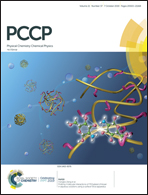Comment on “Atmospheric oxidation reactions of imidazole initiated by hydroxyl radicals: kinetics and mechanism of reactions and atmospheric implications” by Safaei et al., Phys. Chem. Chem. Phys., 2019, 21, 8445†
Abstract
In this short communication, we resolve the discrepancy in chemical kinetics between the recent theoretical work by Safaei et al. (Phys. Chem. Chem. Phys., 2019, 21, 8445) and the experimental measurement for the reaction of imidazole initiated by OH radicals. In particular, using a more comprehensive potential energy surface (PES) explored with the same electronic structure method used by Safaei and coworkers (i.e., M06-2X/aug-cc-pVTZ) and a more rigorous stochastic master equation/Rice–Ramsperger–Kassel–Marcus (ME/RRKM) rate model which includes corrections for the hindered internal rotation and tunneling treatment, we reported the calculated rate constants which are in excellent agreement with the experimental data. Furthermore, it is suggested that imidazole should not be considered as a persistent organic pollutant due to its short atmospheric lifetime of ∼3.7 hours towards the removal of OH radicals.



 Please wait while we load your content...
Please wait while we load your content...